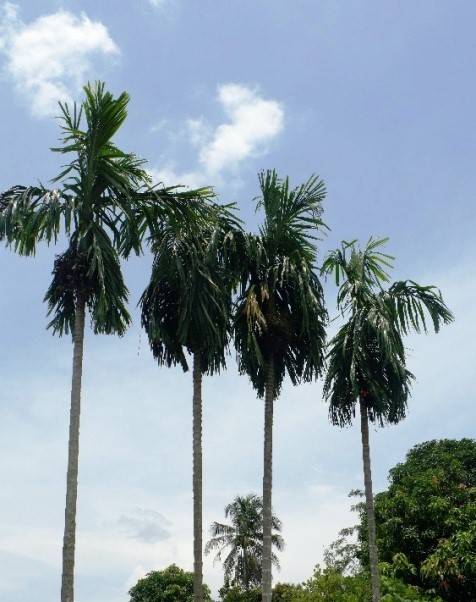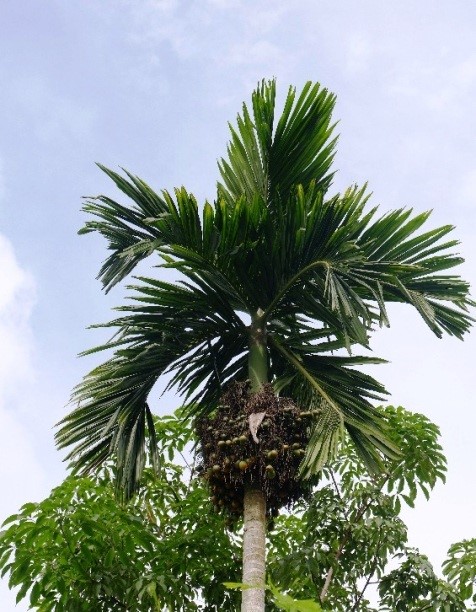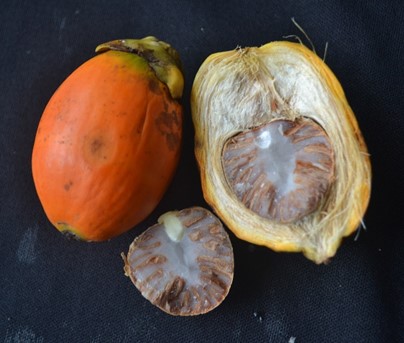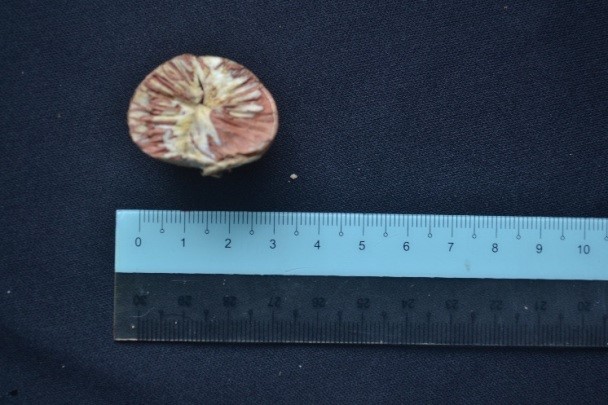Pinang seed
Areca catechu (L.)
Arecaceae
DEFINITION
Pinang seed consists of the powder of dried seeds of Areca catechu (L.) (Arecaceae).
SYNONYM
Areca macrocarpa Becc. [ 1 ].
VERNACULAR NAMES
Areca nut, areca palm, areca nut palm, betel palm, betel nut, betel nut palm (English); Pinang (Malay); Bing lang (Chinese); Kamugu, pakku, pakhumaram (Tamil) [ 2 , 3 , 4 ].
CHARACTER
| Colour | Brown |
| Odour | Characteristics |
| Taste | Astringent |
IDENTIFICATION
Plant Morphology
Areca catechu is an erect, slender and unbranched palm tree grows up to 30 m tall. Trunk is cylindrical, 15–30 cm tall, 10–15(–40) cm in diameter, grey-brown, densely and regularly ringed with leaf scars. Leaves arranged spirally, crowded at the trunk top, 1–1.5 m long, paripinnate, sheath completely encircling the stem like a tube with 0.5–1 m long, pinnae 30–50, subopposite, linear to lanceolate with 30–75 cm long and 3–7 cm wide, longest in the centre of the blade, longitudinally plaited and dark green in color. Inflorescence generally erect, appearing on the trunk below the crown leaves, 30–60 cm long, branched broomlike to 3 orders basally, tertiary branches filiform, spicate, 15–25 cm long, very fragrant, enclosed by a double boat-shaped bract which opens longitudinally along the upper surface. Male flowers present in numerous, borne above the female flowers, arranged in pairs in 2 rows, sessile, about 6 mm long, 3 mm wide, creamy, deciduous; sepals 3, small; petals 3, lanceolate, large; stamens 6 in 2 whorls. Female flowers borne on the thickened bases of secondary and tertiary branches, 1–3 per branch, 1–2 cm long, 1 cm wide, sessile, with persistent perianth of 3 sepals and 3 longer, creamy-white petals; ovary trilocular, ovoid and 2 carpels usually aborting; stigmas 3, triangular and fleshy. Fruits hard, ovoid, 3–6(–10) cm long, 2–5 cm wide, red-orange colored, usually 1-seeded with fibrous pericarp and about 6 mm thick. Seeds known as nuts are ovoid, globose or ellipsoidal, 3–4 cm long, 2–4 cm wide; endosperm ruminate with hard reddish tissue from inner integument running horizontally for some distance into pale brown endosperm. Roots system dense but superficial, most roots within 1 m radius from the trunk in the top 60 cm of soil [ 2 ].
Microscopy
Powdered material consists of fragment of trichome that is simple and multicellular; numerous fragments of parenchyma cells filled with brown content, sometimes with large, slightly and regularly thickened cells, in surface view; fragments of vascular tissues with spirally and annularly thickened vessels.
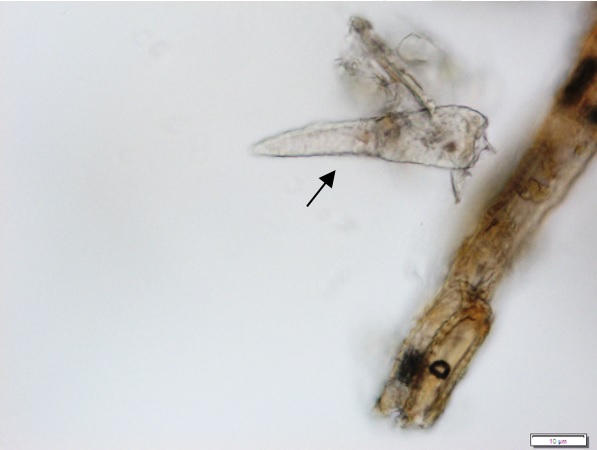
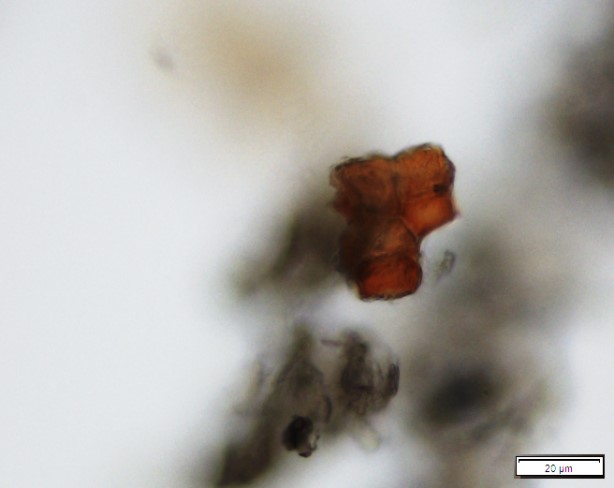
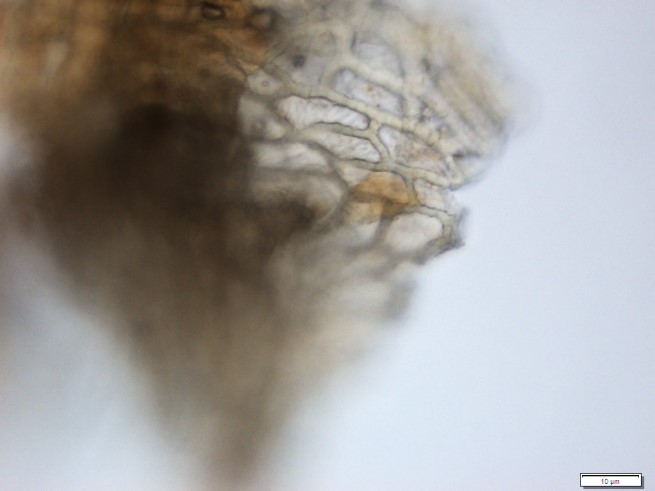
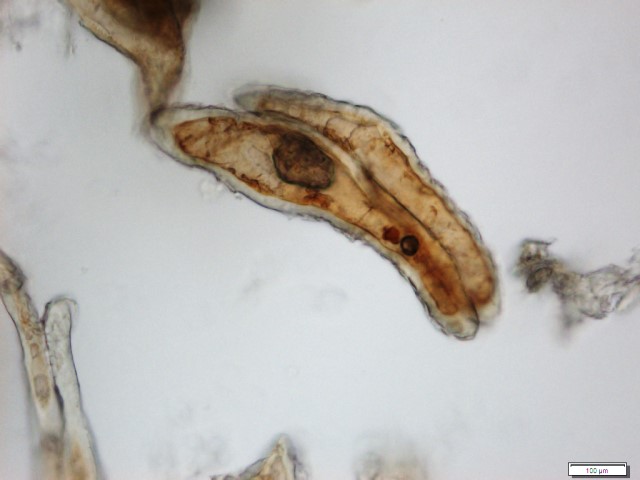
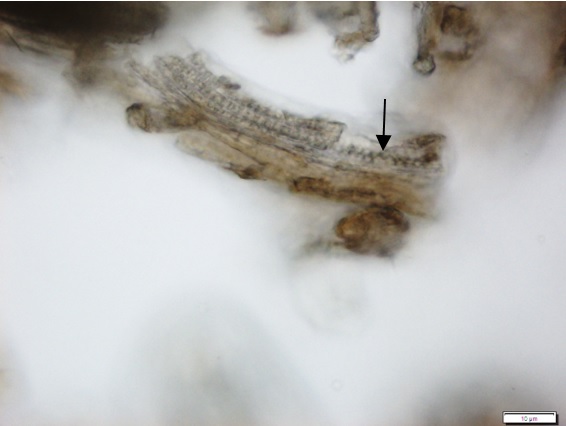
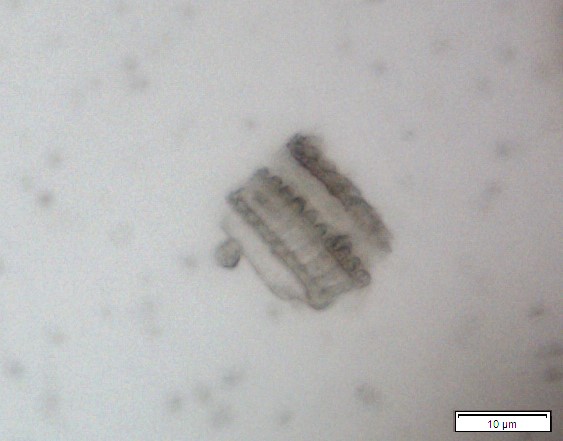
Figure 2 : Microscopic characters of Areca catechu dried seeds powder of 0.355 mm size. (a) Multicellular trichome (arrow) (magnification 40x); (b) parenchyma cells with brown content (magnification 40x); (c) epidermal cell (magnification 40x); (d) parenchyma cells (magnification 4x); (e) spiral vessel (arrow) (magnification 20x); (f) annular vessel (magnification 40x). [Scale bars: a, c, e, f = 10 µm; b = 20 µm; d = 100 µm]
Thin Layer Chromatography (TLC)
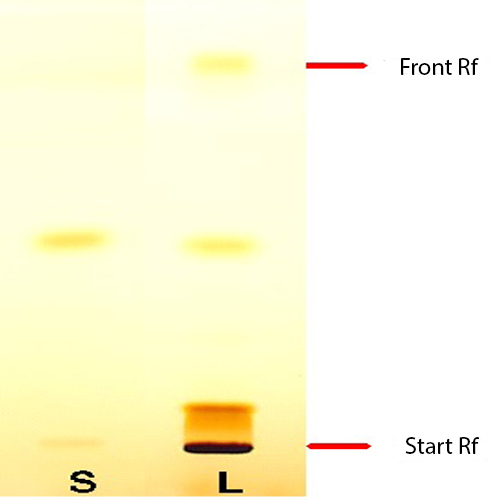
Figure 3 : TLC chromatogram of arecoline hydrobromide (S) at Rf: 0.48 min and methanol extract of Areca catechu dried seeds powder (L) observed under visible light after derivatisation.
| Test Solutions | Weigh about 1.0 g of A. catechu dried seeds powder of 0.355 mm size in 100 mL conical flask. Add 10 mL of methanol and sonicate the mixture for 15 min. Filter the mixture with filter paper and use the filtrate as test solution. |
| Standard solution | Dissolve arecoline hydrobromide standard [CAS no.: 300-08-3] in methanol to give a standard concentration of 1.0 mg/mL. |
| Stationary Phase | HPTLC Silica gel 60 F254 10 x 10 cm |
| Mobile phase | Toluene : ethyl acetate : methanol : ammonia solution 25% (30 : 30 : 10 : 1) (v/v/v/v) |
| Application |
|
| Development distance | 8 cm |
| Drying | Air drying |
| Detection |
Visible light after derivatization of iodine vapour. |
High Performance Liquid Chromatography (HPLC)
| Test solution | Weigh about 1.0 g of A. catechu dried seeds powder of 0.355 mm size in 100 mL conical flask. Add 10 mL of water and sonicate the mixture for 15 min. Filter the mixture with filter paper and use the filtrate as test solution. |
| Standard solution | Dissolve arecoline hydrobromide standard [CAS no: 300-08-3] in water to produce a standard concentration of 0.5 mg/mL. |
| Chromatographic system |
Detector: UV 230 nm Column: C18 (150 X 4.6 mm, 5 µm) (Acclaim Polar Advantage II if necessary) Column oven temperature: 25oC Flow rate: 1 mL/min Injection volume: 10 µL |
| Mobile phase (isocratic mode) | 0.1% trifluoroacetic acid in water (v/v) |
| Run time | 10 min |
| System suitability requirement |
Perform at least five replicate injections of the standard solution (0.5 mg/mL). The requirements of the system suitability parameters are as follow:
|
| Acceptance criteria |
|
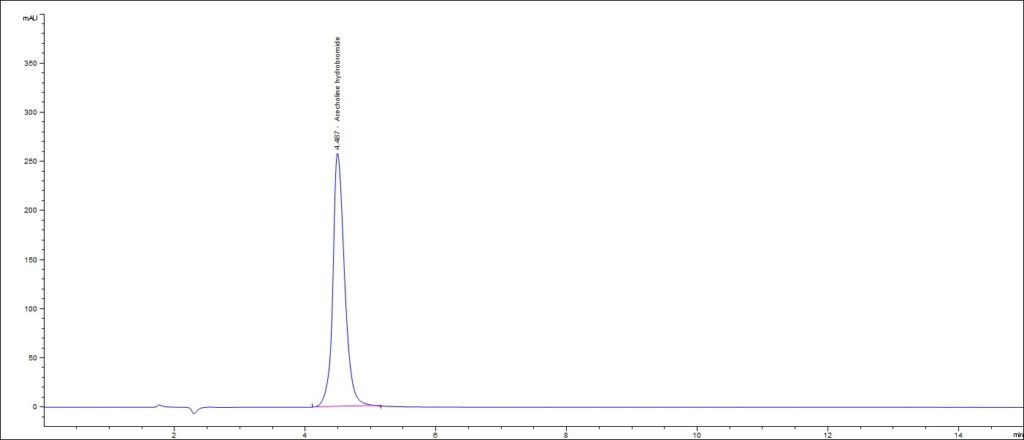
(a)
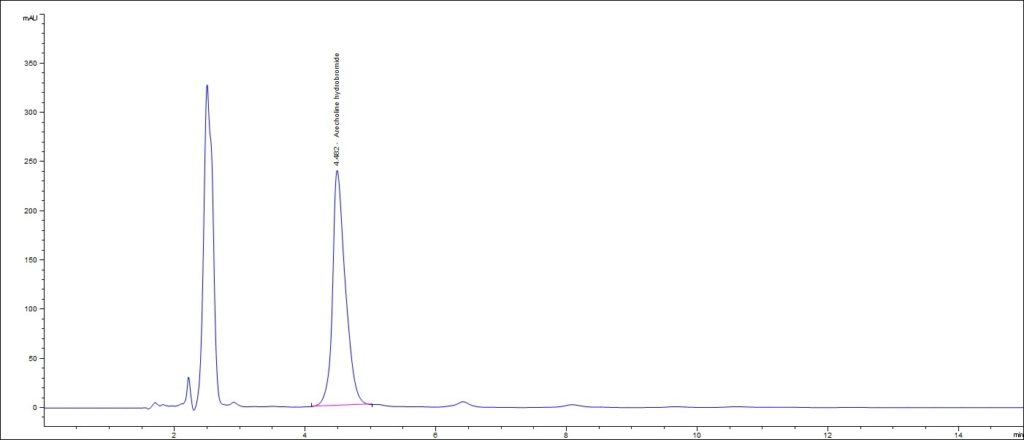
(b)
Figure 4 : Whole HPLC chromatogram of (a) arecoline hydrobromide standard solution (0.5 mg/mL) at tr= 4.487 min and (b) aqueous extract of Areca catechu dried seeds powder showing peak corresponding to arecoline hydrobromide standard solution at tr= 4.482 min.
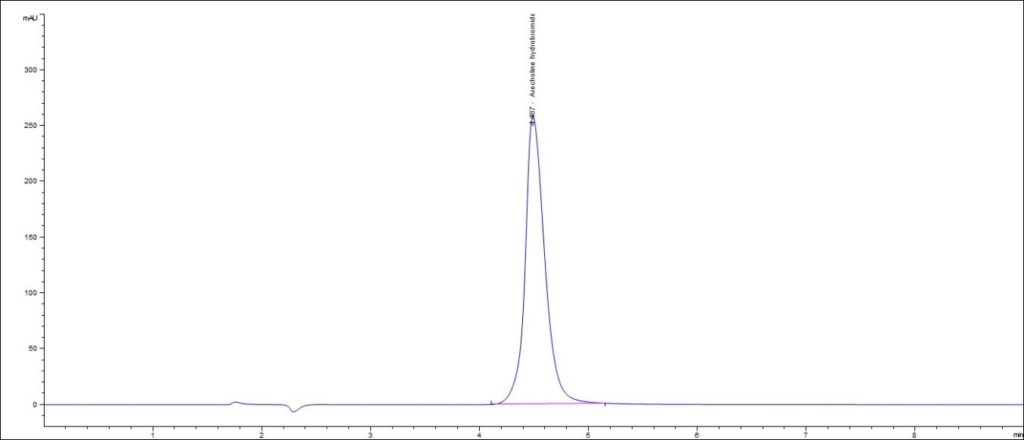
(a)
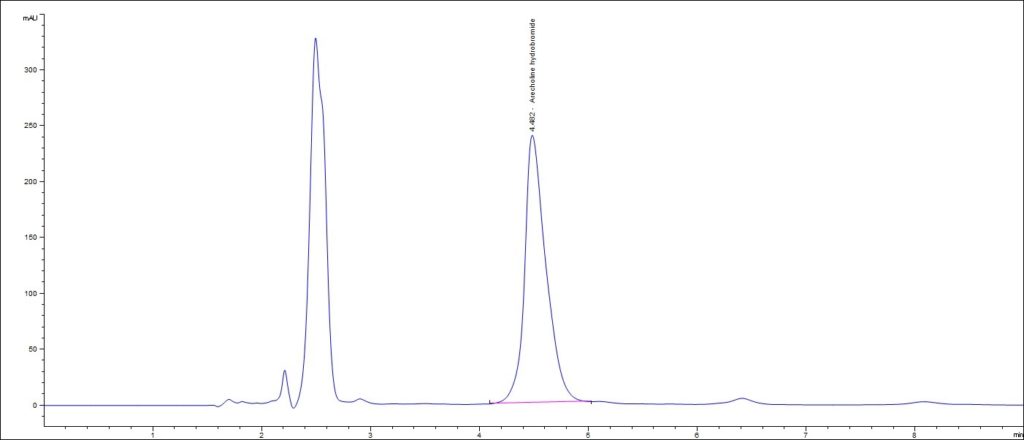
(b)
Figure 5 : HPLC chromatogram highlighting the elution region of arecoline hydrobromide in (a) arecoline hydrobromide standard solution (0.5 mg/mL) and (b) aqueous extract of Areca catechu dried seeds powder showing peak corresponding to arecoline hydrobromide standard solution at tr= 4.482 min.
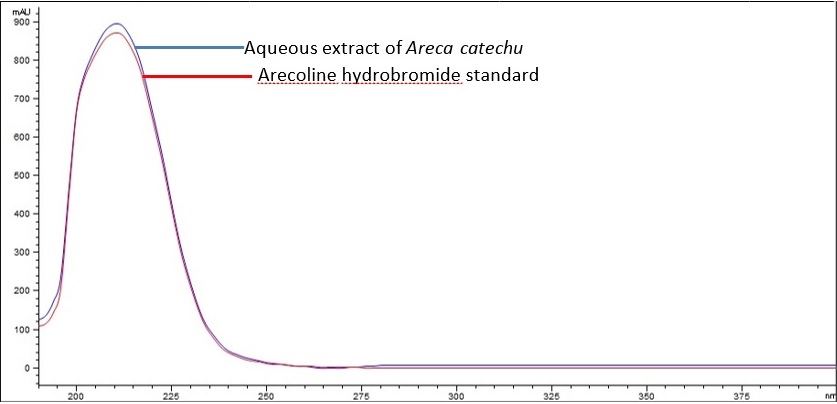
Figure 6 : UV spectrum of arecoline hydrobromide standard solution (0.5 mg/mL) and aqueous extract of Areca catechu dried seeds powder.
PURITY TESTS
The purity tests, except foreign matter test, are based on A. catechu dried seeds powder of 0.355 mm particle size.
| Foreign Matter |
| Not more than 2% |
| Ash Contents | |
| Total ash | Not more than 2% |
| Acid-insoluble ash | Not more than 1% |
| Loss on Drying |
| Not more than 10% |
| Extractive Values | |
| Water-soluble extracts | |
| Hot method | Not less than 16% |
| Cold method | Not less than 14% |
| Ethanol-soluble extracts | |
| Hot method | Not less than 17% |
| Cold method | Not less than 16% |
SAFETY TESTS
The safety tests are based on A. catechu dried seeds powder of 0.355 mm particle size.
| Heavy Metals | |
| Arsenic | Not more than 5.0 mg/kg |
| Mercury | Not more than 0.5 mg/kg |
| Lead | Not more than 10.0 mg/kg |
| Cadmium | Not more than 0.3 mg/kg |
| Microbial Limits | |
| Total bacterial count | Not more than 105 cfu/g |
| Total yeast and mould count | Not more than 104 cfu/g |
| Bile-tolerant gram negative | Not more than 104 cfu/g |
| Specific Pathogens | |
| Salmonella spp. | Absent in 25 g |
| Escherichia coli | Absent in 1 g |
| Staphylococcus aureus | Absent in 1 g |
| Pseudomonas aeruginosa | Absent in 1 g |
CHEMICAL CONSTITUENTS
Aqueous extract of A. catechu dried seeds was found to contain alkaloids (e.g. arecoline) and flavonoids (e.g. catechin, epicatechin, isorhamnetin-3-O-rutinoside, procyanidin trimer, procyanidin dimers (B1), procyanidin trimers and procyanidin dimers (B2)) [ 5 , 6 ].
Aqueous acetone (50%) extract of A. catechu dried seeds was found to contain flavonoids (e.g. procyanidin B1, arecatannin A1 and arecatannin B1) [ 7 ].
Ethanol (70%) extract of A. catechu dried seeds was found to contain flavonoid (e.g. epicatechin) and phenolic acid (e.g. syringic acid) [ 8 ].
Ethanol (95%) extract of A. catechu fresh seeds was found to contain alkyl esters (e.g. catalpinic acid), flavonoids (e.g. isorhamnetin, chrysoeriol, luteolin, (±)-4’,5-dihydroxy-3’,5’,7-trimethoxyflavonone, jacareubin and 2S,3R)-ent-catechin), phenol (e.g. 4-[3’-(hydroxymethyl)oxiran-2’-yl]-2,6-dimethoxyphenol), phenolic acid (e.g. protocatechuic acid), phenolic aldehyde (e.g. isovanillic acid) and monolignol (e.g. epoxyconiferyl alcohol) [ 9 ].
Methanol extract of A. catechu fresh seeds was found to contain alkaloids (e.g. arecoline, arecaidine, guvacine and guvacoline) [ 10 ].
Methanol extract of A. catechu dried seeds was found to contain fatty acids (e.g. lauric acid, myristic acid, pentadecanoic acid, palmitic acid, oleic acid, stearic acid and nonadecanoic acid) [ 11 ].
Acetone extract of A. catechu fresh seeds was found to contain tannins (e.g. (-)-epicatechin, procyanidin A1, procyanidin B1, procyanidin B2, procyanidin B7, arecatannin A1, arecatannin B1, arecatannin C1, arecatannin A2, arecatannin A3 and arecatannin B2 [ 12 ].
Dichloromethane extract of A. catechu dried seeds was found to contain alkaloid (e.g. arecoline) [ 13 ].
MEDICINAL USES
Uses described in folk medicine, not supported by experimental or clinical data
Traditionally, the nut of A. catechu is used as a vermifuge and alleviate the intestinal problems. Meanwhile, the decoction of the nut is used for diarrhea. The pulp of young nut is used for stomach pain. The juice of young nut is taken to alleviate hematuria. For external use, the juice of young nut is used for fever and headache [ 14 ].
Biological and pharmacological activities supported by experimental data
Antioxidant activity
Aqueous extract of A. catechu dried seeds exhibited 1,1-diphenyl-2-picrylhydrazyl (DPPH) radical scavenging activity with 50% inhibition concentration (IC50) value of 7.5 µg/mL compared to ascorbic acid (IC50 = 4.8 µg/mL) using DPPH assay [ 6 ].
Aqueous ethanol (50%) extract of A. catechu dried seeds exhibited 1,1-diphenyl-2-picrylhydrazyl (DPPH) radical scavenging activity with 50% scavenging concentration (SC50) value of 1.38 µg/mL compared to ascorbic acid (SC50= 2.21 µg/mL) using DPPH assay [ 15 ].
Ethanol extract of A. catechu dried seeds exhibited 1,1-diphenyl-2-picrylhydrazyl (DPPH) radical scavenging activity with IC50 value of 10.2 µg/mL compared to ascorbic acid (IC50 = 29.7 µg/mL), α-tocopherol (IC50 = 33.5 µg/mL) and butylated hydroxytoluene (BHT) (IC50 = 37.2 µg/mL) using DPPH assay [ 16 ].
Ethanol extract of A. catechu dried seeds showed lipid peroxidation activity with IC50 value of 45.4 µg/mL compared to α-tocopherol (IC50 = 33.6 µg/mL) and ascorbic acid (IC50 = 219.0 µg/mL) using thiobarbituric acid (TBA) assay [ 16 ].
(2S,3R)-ent-catechin and jacareubin isolated from ethyl acetate fraction of 95% ethanol extract of A. catechu fresh seed exhibited DPPH radical scavenging activity with 50% scavenging concentration (SC50) value of 19.2 µmol/L and 19.7 µmol/L compared to ascorbic acid (SC50 = 28.9 µmol/L) using DPPH assay [ 9 ].
Antifungal activity
Aqueous extract of A. catechu dried seeds (16.67 µg/mL)inhibited the growth of Candida albicans with inhibition zone of 18 mm compared to amphotericin B (16 mm) and nystatin (20 mm) using disc diffusion method [ 17 ].
Antilipoxygenase activity
Aqueous ethanol (50%) extract of A. catechu dried seeds exhibited 5-LOX inhibitory activity with IC50 value of 25.07µg/mL compared to nordihydroguaiaretic acid (IC50 = 59.50 µg/mL) using deoxyribose assay [ 15 ].
Antityrosinase activity
Ethanol extract of A. catechu dried seeds showed in vitro tyrosinase inhibitory activity with IC50 value of 0.48 mg/mL compared to arbutin (IC50 = 6.52 mg/mL) [ 16 ].
Antimelanogenesis activity
Ethanol extract of A. catechu dried seeds (2 mg/mL) exhibited in vitro anti-melanogenesis in B-16 melanoma cells (ATCC CRL 6323) in dose dependent manner with inhibition percentage of 86.3 ± 7.1% and melanin content of 0.007 ± 0.003 µg/L x106 cell compared to negative control (% of inhibition = 0.00 ± 4.0%; melanin content = 0.051 ± 0.002 µg/L x106 cell) [ 16 ].
Anti-inflammatory activity
Ethanol extract of A. catechu dried seeds (3 x 50 mg/ear) topically applied to the right ears of mice (18 – 22 g) for three times at three-hour intervals after induction of ear edema using croton-oil significantly (p < 0.05) inhibited the edema thickness with inhibition percentage of 24% compared to prednisolone (36% inhibition percentage) [ 16 ].
Aqueous fraction of methanol (70%) extract of A. catechu dried seeds (100 mg/kg) was orally administered to either sex of BALB/c mice (20 – 30 g) 30 min before induction of paw edema using carrageenan. The extract showed significant (p < 0.001) reduction in the paw edema volume with inhibition percentage of 76% compared to aspirin (45% inhibition percentage) [ 20 ].
Antiaging activity
Ethanol (90%) extract of A. catechu dried seeds (1×10-4% concentration) showed significant (p < 0.05) increased in the in vitro cell proliferation of human fibroblast with 185% of cell viabilities compared to ascorbic acid (150%) [ 18 ].
Ethanol (90%) extract of A. catechu dried seeds (1×10-4% concentration) significantly (p < 0.05) increased the in vitro collagen synthesis by 140% compared to ascorbic acid (104%) [ 18 ].
Clinical studies
Information and data have not been established.
SAFETY INFORMATION
Preclinical studies (Toxicology studies)
14-days oral toxicity study
Aqueous ethanol (50%) extract of A. catechu dried seeds powder (2000 mg/kg) was administered orally at a single dose to adult female albino Swiss mice (25 – 30 g) and were observed for 14 days. No mortality and toxic effect were observed throughout the study with lethal dose 50% (LD50) > 2000 mg/kg [ 19 ].
Oral single dose acute toxicity study on female Sprague Dawley rats (aged between 7 and 12 weeks old) using aqueous extract of A. catechu seeds showed no toxic effect on the parameters observed, including behavior, body weight, food and water intake. There were episode of loose stools occurred within four hours after administration of 2,000 mg/kg body weight but this condition resolved thereafter. All rats were observed for 14 days prior to necropsy. No death was found throughout the study period. The observed loose stool episodes could be from toxicity of effect of high dose (at 2,000 mg/kg body weight). Necropsy revealed no significant abnormality but several histological lesions were found for the high dose. No- observed-adverse-effect level (NOAEL) is less than 2,000 mg/kg body weight [ 21 ].
Others (Adverse reaction, contraindications, side effects, warning, precautions)
Information and data have not been established.
DOSAGE
In Chinese pharmacopoeia, the recommended dosage is 3 – 10 g of dried ripe seed [ 4 ]. To dispel tapeworm and intestinal flukes, the recommended dosage is 30 – 60 g of dried ripe seed [ 3 ].
STORAGE
Store below 30°C. Protect from light and moisture.
REFERENCES
- The plant List. [Internet] Areca catechu L.; Version 1.1; [cited on 25th September 2017]. Available from: http://www.theplantlist.org/tpl1.1/record/kew-14517
- PROSEA (Plant Resources of South-East Asia). [Internet] Areca catechu Brotonegoro S, Wessel M, Brink M ; 2000 [cited on 25th September 2017]. Available from: http://proseanet.org/prosea/e-prosea_detail.php?frt=&id=90
- Quattrocchi UFLS. CRC world dictionary of medicinal and poisonous plants: common names, scientific names, eponyms, synonyms, and etymology. Vol. III E-L. United States: CRC Press. 2012; p.368-369.
- Chinese Pharmacopoeia Commission. Pharmacopoeia of the People’s Republic of China. Vol. 1. Beijing: China Medical Science Press. 2010; p.44-45.
- Chavan YV, Singhal RS. Separation of polyphenols and arecoline from areca nut (Areca catechu L.) by solvent extraction, its antioxidant activity, and identification of polyphenols. Journal Science Food Agriculture. 2013;93:2580-2589.
- Sazwi NN, Nalina T, Rahim HAZ. Antioxidant and cytoprotective activities of Piper betle, Areca catechu, Uncaria gambir and betel quid with and without calcium hydroxide. BMC Complementary and Alternative Medicine. 2013;13:351.
- Kusumoto IT, Nakabayashi T, Kida H, Miyashiro H, Hattori M, Namba T.Screening of Various Plant Extracts used in Ayurvedic Medicine for Inhibitory Effects on Human Immunodeficiency Virus Type 1 (HIV-1) Protease.Phytotherapy Research. 1995;9:180-184.
- Zhang WM, Huang WY, Chen WX, Han L, Zhang HD. Optimization of Extraction Conditions of Areca Seed Polyphenols and Evaluation of Their Antioxidant Activities. Molecules. 2014;19:16416-16427.
- Zhang X, Wu J, Han Z, Mei WL, Dai HF. Antioxidant and cytotoxic phenolic compounds of areca nut (Areca catechu). Chemical Research in Chinese Universities. 2010;26(1):161-164.
- Srimany A, George C, Naik HR, Pinto DG, Chandarkumar N. Developmental patterning and segregation of alkaloids in areca nut (seed of Areca catechu) revealed by magnetic resonance and mass spectrometry imaging. Phytochemistry. 2016;125:35-42.
- Hada S, Kakiuchi N, Hattori M, Namba T. Identification of antibacterial principles against Streptococcus mutans and Inhibitory Principles Against Glucosyltransferase from the seed of Areca Catechu L. Phytotherapy Research. 1989;3(4):140-144.
- Ma YT, Hsu FL, Lan SJJ, Chen CF. Tannins from betel nuts. Journal of the Chinese Chemical Society. 1996;43:77-81.
- Jantarat C, Sirathanarun P, Songserm W, Srinornate W, Daengprom S. A simple and rapid HPLC technique for determination of arecoline in areca nut (Areca catechu L.) extract. Walailak Journal of Science & Technology. 2013;10(1):57-66.
- Burkill IH. A dictionary of the economic product of the Malay Peninsula, Vol.1. London; Published on behalf of the governments of the Straits settlements and Federated Malay states by the Crown agents for the colonies. 1935; p. 223-229.
- Pithayanukul P, Nithitanakool S and Bavovada R.Hepatoprotective Potential of Extracts from Seeds of Areca catechu and Nutgalls of Quercus infectoria. Molecules. 2009;14:4987-5000.
- Lee KK, Choi JD. The effects of Areca catechu L. extract on anti-inflammation and anti-melanogenesis. International Journal of Cosmetic Science. 1999;21: 275-284.
- Anthikat RRN, Michael A, Kinsalin VA, Ignacimuthu S. Antifungal activity of Areca catechu L. International Journal of Pharmaceutical and Clinical Science. 2014;4(1):1-3.
- Lee KK, Choi JD. The effects of Areca catechu L extract on anti-aging. International Journal of Cosmetic Science. 1999;21:285-295.
- Bhandare A, Kshirsagar A, Vyawahare N, Sharma P, Mohite R. Evaluation of anti-migraine potential of Areca catechu to prevent nitroglycerin-induced delayed inflammation in rat meninges: Possible involvement of NOS inhibition. Journal of Ethnopharmacology. 2011;136:267-270.
- Khan S, Mehmood MH, Ali ANA, Ahmed FS, Dar Am, Gilani AH. Studied on anti-inflammatory and analgesic activities of betel nut in rodents. Journal of Ethnopharmacology. 2011;135:654-661.
- Teh BP, Noorashikin AH, Suganthi J, Lalitha Suganthi S, Puspawathy K, Wan Nurul Nadia WS, Nur Salsabeela MR, Siau TC. Acute oral toxicity study of selected Malaysian medicinal herbs (Area catechu seeds) on Sprague Dawley rats. Institute for Medical Research, Ministry of Health; 2020. Report no.: NON-GLP/2020/02/01.

